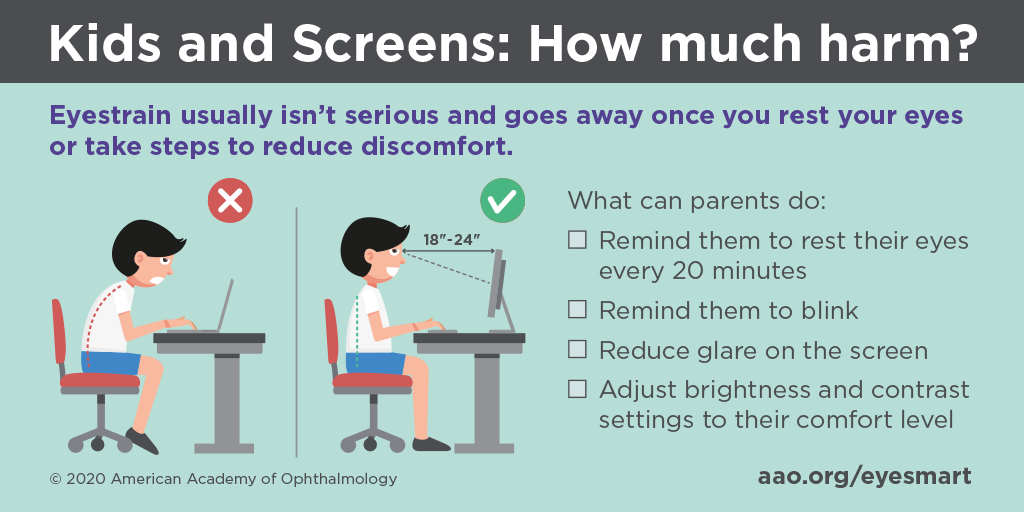“I was a digital eye strain naysayer prior to recent events,” said Stephen Lipsky, MD, pediatric ophthalmologist and clinical spokesperson for the American Academy of Ophthalmology. “But in my practice, I really have seen a marked increase in kids suffering from eye strain because of increased screen time. Good news is most symptoms can be avoided by taking a few simple steps.”
The simple fact behind the headaches, blurry vision, and tired, dry eyes is that we don’t blink as often while using computers and other digital devices, leaving eyes dry and irritated. And when we focus at the same distance for a long time, it can cause our vision to blur temporarily, and the muscles around the eye to tire, which can cause headaches. Extended reading, writing or other intensive near work can also cause eye strain.
To fix this problem, ophthalmologists — physicians specializing in medical and surgical eye care — recommend taking a 20 second break from near work every 20 minutes. Here are some tips to help parents remind kids to follow this vital rule:
- Set a timer. Whether a kitchen timer or a smart device, use it to remind your child to take a break every 20 minutes.
- Alternate reading an e-book with a real book. Encourage children to look up and out the window every two chapters or simply shut their eyes for 20 seconds.
- Pre-mark books with paperclips every few chapters. When they reach a paper clip, it will remind them look up. On an e-book, use the “bookmark” function for the same effect.
Good ergonomics is as important as resting the eyes periodically. We tend to use digital devices at less than ideal distances and angles, which leads to eyestrain. To encourage good posture and better habits, set up a “home office” for your kids. Follow these tips to optimize their workspace:
- Make sure they view laptops at arm’s length, about 18 to 24 inches from where they are sitting. Ideally, they should have a monitor positioned at eye level, directly in front of the body. Tablets should also be held at arm’s length.
- To reduce glare, position the light source behind the back, not behind the computer screen.
- Adjust the brightness and contrast on the screen so that it feels comfortable for them.
- Don’t use a device outside or in brightly lit areas; the glare on the screen can cause eye strain.
- Avoid using a device in a dark room. As the pupil expands to accommodate the darkness, the brightness of the screen can aggravate after-images and cause discomfort.
- Put down the device 30 to 60 minutes before bedtime. Blue light may disrupt sleep. For your procrastinating teens, switch to “night mode” or a similar mode to reduce blue light exposure.
Lastly, make sure they spend some time outdoors. Computer use and other near work activities may be driving a worldwide epidemic of nearsightedness in children, although this is not yet proven. However, several studies suggest that spending time outdoors, especially in early childhood, can slow the progression of nearsightedness.
For more information on eye health, visit www.eyesmart.org
About the American Academy of Ophthalmology The American Academy of Ophthalmology is the world’s largest association of eye physicians and surgeons. A global community of 32,000 medical doctors, we protect sight and empower lives by setting the standards for ophthalmic education and advocating for our patients and the public. We innovate to advance our profession and to ensure the delivery of the highest-quality eye care. Our EyeSmart® program provides the public with the most trusted information about eye health. For more information, visit aao.org.
Original post https://alertarticles.info


